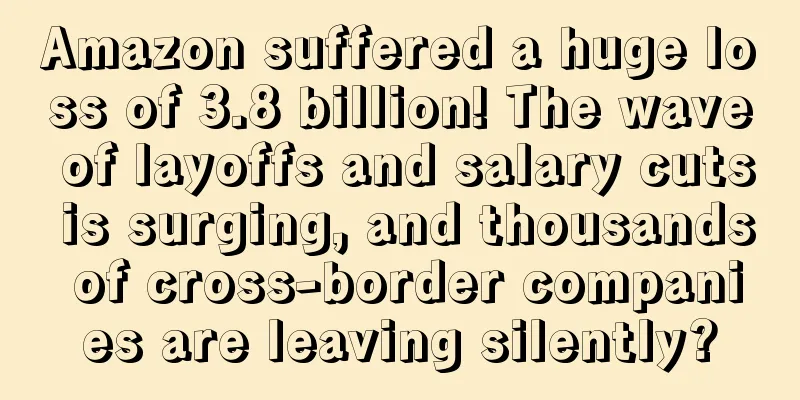Costs for a large number of sellers have increased! Did Amazon secretly adjust this fee?

|
The annual Prime Day The two-day promotion ended perfectly. Judging from the results, Amazon sellers are mixed. Some sellers are happy and some are sad. Some sellers have a bumper harvest of traffic and orders, some sellers have a dismal profit and lose money to make a profit, and some sellers have mediocre sales and are forced to run away with the competition... Now that the big promotion is over, the overseas journey in the second half of the year has just begun. What follows are various operational challenges: consumer demand is overdrawn, sales costs are rising, etc. In addition to internal troubles, the "external trouble" from Amazon is also looming - according to feedback from many sellers, Amazon may secretly adjust the storage configuration fee. On March 1, 2024, Amazon's inbound configuration service fee will officially take effect. When creating a shipping plan, sellers will see the estimated cost of each available shipping configuration option. Amazon will charge sellers the Amazon Logistics inbound configuration service fee 45 days after receiving the shipment based on the actual shipping location and quantity received. The industry was in uproar when this news came out. For many sellers whose profits were already tight, this sudden warehousing and configuration fee will undoubtedly increase the cost burden again. To make matters worse, it has been more than four months since the warehousing configuration fee officially came into effect, but during the hot Prime Day, many sellers found that the warehousing configuration fee has increased to varying degrees. According to a seller, "I recently discovered that for several shipments, when I chose to ship them to the West Coast in three shipments, the warehousing configuration fees actually changed. The warehousing configuration fees were very different when they were shipped to three different West Coast warehouses at different times. Did Amazon secretly increase the configuration fees? Or do the configuration fees vary when shipped to different West Coast warehouses?" It is reported that the same batch of goods packed by the seller last week were divided into three warehouses: GYR3, LGB8, and GYR2, and the configuration fee was 170 yuan. However, the seller did not ship the goods immediately. When the warehouse was reset this week, the distribution warehouses became ONT8, SBD1, and SCK4, and the configuration fee soared to 290 US dollars. The seller tried to send other products, but found that the final configuration fee had increased. This situation also resonates with many sellers: "I tried to create it, and the price of each same SKU and quantity increased by more than 40% compared to before. Today's creation is dozens of times more expensive than last week." "The charges for 2 warehouses and 3 warehouses in the US West are now the same. In fact, the charges for 3 warehouses in the US West have increased compared to last week, and have been raised to the same standard as 2 warehouses in the US West." "Today, the configuration fee for creating a shipment and shipping it has increased from $0.33 to $0.48. A month ago, the same three warehouses had a storage fee of $0.3. After testing four stores, all of them have increased to $0.48. Before that, no matter what warehouse it was, the three warehouses in the West Coast were all $0.33." A seller tested and found that the delivery fee for a shipment on July 6 was $253. The configuration fee for re-setting the warehouse with the same packaging method and shipment volume increased to $360. The former was shipped using LAS1, LGB8, GYR3, while the latter was shipped using LGB8, ONT8, SBD1. According to feedback from many parties, the most common situation is that the warehouse configuration fee has increased by about 30% to 40%. Some sellers revealed that since July, they have found that the warehouse consolidation fee of three warehouses in the western United States is much more expensive than in March: 1. In March, 1,000-1,500 pieces were shipped to three warehouses in the western United States, and the price per piece was 0.3-0.33 USD/piece; 2. In July, 1,000 to 1,500 pieces were shipped to three warehouses in the western United States, which means each piece cost 0.42 to 0.46 USD. Some sellers speculate that the change in warehousing configuration fees may be due to differences in geographical locations and operating costs of different warehouses, and Amazon's dynamic pricing It is reported that Amazon does not have an accurate standard for allocation fees, but only provides a fee range. Most of the time, when the number of warehouses is the same, the allocation fee is in the West Coast > the Central Coast > the East Coast, but this is not absolute. On the other hand, due to the hot preparations for Prime Day, Amazon FBA has recently Warehouses are constantly overstocked. The above-mentioned warehouses that have increased their prices are all overstocked and difficult to book, which has led to an increase in charging standards. However, what makes many sellers quite dissatisfied is that, as of now, Amazon has not issued a specific price increase announcement, but has only secretly raised the fees. In any case, facing this "Schrödinger's configuration fee", sellers must first pay attention to regularly monitoring rate changes, secondly, optimize warehouse distribution strategies, choose warehouses with low configuration fees, avoid "peak periods", and thirdly, plan delivery times in advance to avoid the "chain mines" of the logistics peak season. Although Prime Day 2024 has come to a successful conclusion, the challenges for cross-border sellers have just begun. In addition to the need to guard against occasional price increases on the platform, a series of aftereffects of the big promotion are also a pain point for many sellers. According to foreign media reports, this year's Amazon Prime Day event once again set a sales record, with total sales over two days reaching US$14.2 billion, an increase of 11% year-on-year. According to a report by Adobe Analytics, on the first day of Prime Day, consumers spent $7.2 billion online, up 11.7% year-on-year; on the second day, consumers spent $7 billion online, up 10.4% year-on-year. It is also predicted that due to the continued impact of the promotion, spending for the whole month of July will reach $84.4 billion, and by the end of September, the annual online spending is expected to reach $732 billion. Previously, in the article "Prime Day Order Volume Soars! Sellers: Just Promoting at a Loss", we reported on the sales situation of the promotion: 60% of sellers doubled their sales, and achieved a bumper harvest in both traffic and orders. However, behind the strong boost of the big promotion, it can be said that to a certain extent, consumer demand has been overdrawn in advance. This can be seen during the big promotion period - many sellers who had a huge number of orders on the first day saw their orders cut in half the next day. As the big promotion came to an end, the situation became even worse: "The sales on Prime Day were OK, twice as much as usual, but after Prime Day, the sales were terrible." "It's really cold today. Everyone in the category is offering 25% coupons. It's killing me." "The membership day increased six times in two days, and the membership day will return to the pre-liberation period." "There really is no volume of orders today. I feel like I have to use the orders before and after to make up for the PD's orders." Although many sellers achieved exponential sales growth during the membership day, there is a hidden pain behind the glamour - thin or even negative profits. "Sales are good but profits are all negative, which is definitely giving benefits to foreigners." Not only that, a series of operational problems also plagued many sellers. On the one hand, the advertising conversion rate The conversion rate of competing products with price advantages is unsatisfactory, especially the pt conversion rate is particularly poor. On the other hand, the return rate has soared exponentially, and after-sales problems such as returns and claims have followed one after another. One seller said helplessly: "There are a lot of returns and claims to deal with. It feels like a lot of orders have been placed, but in reality, it seems that there are nothing." For Amazon sellers, although Prime Day has ended, subsequent operational follow-up and preparations for the peak season in the second half of the year are equally important to ensure stable and long-term growth. Specifically, it includes adjusting the product status of pre-sale dates, optimizing coupon strategies, rationally managing inventory, adjusting advertising budgets, checking changes in keyword rankings, managing redundant inventory, and customizing brand promotions, thereby effectively improving the overall performance of the store and continuously enhancing its advantages in the fierce market competition. Prime Day has passed, is Black Friday and Cyber Monday far behind? For cross-border sellers, no matter what the results of Prime Day are, the battle in the second half of the year has just begun... |
<<: Biden withdraws from the election, Trump and Harris peripherals dominate Amazon BSR!
Recommend
Canadian retail e-commerce will maintain strong growth in 2021! Sales are expected to reach 86.52 billion Canadian dollars
It is learned that eMarketer recently released the...
What is ARAMEX Express? ARAMEX Express Review
Aramex is the most famous express delivery company...
What is White Whale? White Whale Review
Baijing Overseas is a comprehensive service platfo...
The US Senate has come up with a new move! It wants to restrict mergers and acquisitions of large companies such as Amazon and Google!
It is learned that two senators from the U.S. Sena...
FedEx pilots vote to strike! Summer package delivery in the United States may be disrupted!
It is learned that according to foreign media repo...
What is Cross-border World ERP? Cross-border World ERP Review
Cross-border World ERP is a professional managemen...
What is the United States Patent and Trademark Office (USPTO)? Review of the United States Patent and Trademark Office (USPTO)
The United States Patent and Trademark Office (PTO...
Quickly search for all infringing keywords in the listing
Infringement is a very serious violation of the Am...
Container throughput drops sharply! U.S. ports are no longer as busy as they used to be!
According to the latest monthly Global Port Tracki...
Shenzhen Port was hit hard! Just now, Hong Kong officially implemented...
Recently, a piece of news has caused mainland shi...
Optimization strategies when Amazon ads are underperforming!
Amazon advertising is an effective tool to increas...
Orders surged 100%, but profits plummeted! Cross-border sellers exclaimed: How can people live like this? !
Preface / In the past 2020, although affected by ...
Online alcohol sales in the United States reached $6.1 billion in 2021! Strong growth is expected to continue in 2022!
<span data-shimo-docs="[[20,"获悉,根据荷兰合作银行(&...
What is Bow & Drape? Bow & Drape Review
Bow & Drape is a women's clothing store lo...
What is Reindeer Crossing? Reindeer Crossing Review
Company Profile: Reindeer Cross-border Business Se...









